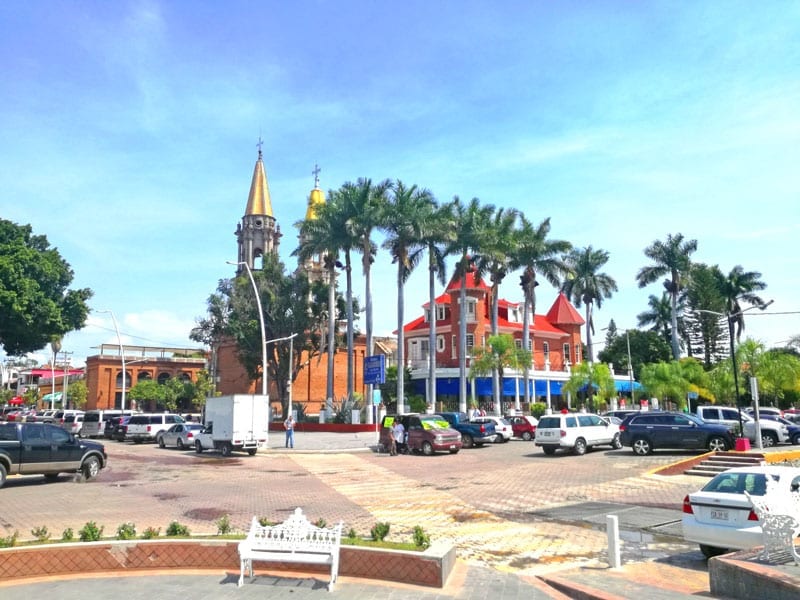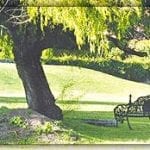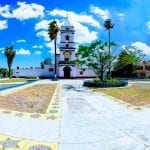Chapala is a vibrant town located on the shores of the largest lake in Mexico, Lake Chapala. It is a popular tourist destination due to its rich culture, scenic beauty, and welcoming people. From its stunning lakeside landscapes to its vibrant local markets, Chapala is a destination that captivates the hearts of both locals and visitors alike.
This beautiful town, itself is a charming lakeside community that has become a haven for expatriates, retirees, and travelers seeking an idyllic escape from the hustle and bustle of city life.
The sunsets are nothing short of magical. As the sun dips below the horizon, the sky is painted with hues of orange, pink, and purple, casting a spellbinding reflection on the tranquil waters of the lake. Many visitors find solace in witnessing these breathtaking moments.
Chapala’s allure extends beyond tourism, as it has become a sought-after retirement destination for expatriates from around the world. Its affordable cost of living, pleasant climate, and welcoming community make it an attractive place to spend one’s golden years.
Is a true paradise that seamlessly weaves together natural beauty, cultural richness, and a warm community spirit. From its captivating lake views to its vibrant festivals, Chapala offers an authentic Mexican experience that lingers in the hearts of all who visit.
HISTORY
In 1521-22, Franciscan evangelists, sent from Spain by Catholic King Ferdinand and Queen Isabella to Christianize the natives, baptized Chief Chapalac, and named him “Martin of Chapala,” master of the people, owner of the land. In exchange, the Taltica Indian chief destroyed his god, Iztlacateotl.
In 1538, Franciscan Fray Miguel Bolonia founded the city of Chapala. He built a hermitage on Chapala’s highest hill, Cerro San Miguel, where he lived until his death. He built another hermitage on the island of Mezcala, where native children were given religious instruction.
In 1548, a church was built of adobe and grass, and named San Francisco after the order of the padres. A hospital was constructed, adjoining the church.
By 1550, Chapala had a population of 825 married persons and 349 children. About this time, a scholar from Spain, studying Indian cultures of the Chapala shores, found that each lakeside community seemed to have its own language. Probably, the lack of transportation (the rough dugout fishing canoes were not capable of crossing the lake) had prevented a common language from developing.
On September 10, 1864, Chapala became a municipality by decree of the Jalisco State Congress.
ACTIVITIES TO ENJOY IN CHAPALA
Chapala is an exciting tourist destination with much to offer. From its natural beauty to its delicious cuisine, its beautiful boardwalk and colorful handicrafts. There will always be something for everyone in this charming place.
LOCATION
Chapala is located on the north shore of Lake Chapala, 26 km. (16 mi.) east of the Lake’s western end, and 42 km. (25 mi.) south of Guadalajara. It is the oldest, most populated, and the most easterly of a string of villages – Chapala, San Antonio Tlayacapan, Ajijic, San Juan Cosala and Jocopetec – known locally as Lakeside.
Its altitude is 1530 meters (5020 feet). Its average temperature is 19.9 degrees C (68 degrees F).
PEOPLE
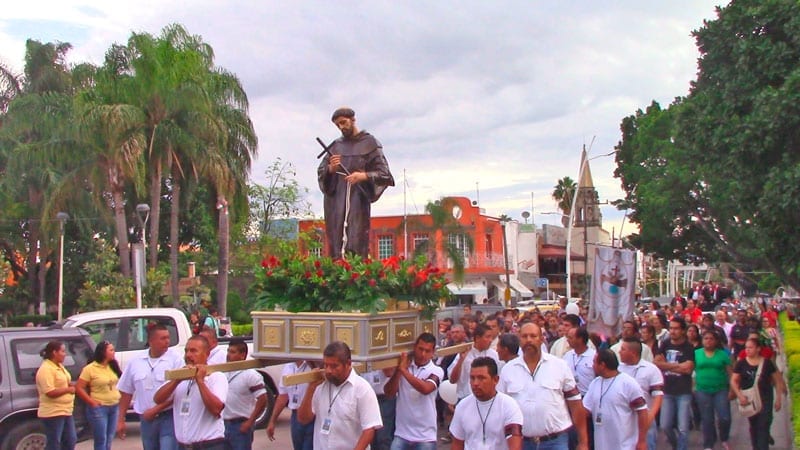
About 1,000 B.C., roaming Indian tribes drifted into the Lake Chapala basin, a paradise rich with fish, fowl, reeds and mud for shelters, grasses for mats, baskets and clothing. As time passed, some of the wanderers stayed behind, eventually making permanent settlements.
From the XVI to the XVIII centuries Chapala was only partially commissioned by the Spanish Crown, being inhabited mainly by indigenous people, in spite of the fact that the process of European colonization had started back in the XVI century.
In addition to the first European colonization in the XVI century, the period 1895 to the decade of the ’30s of the present century, Chapala gave shelter among its population to a good number of foreigners of diverse nationalities, as well as to those of our fellow countrymen who began promoting tourism along the lakeside.
Since the 1960s, Chapala has been frequented by both Mexican and international tourists.
MEANING

“Grasshoppers Over the Water” – Nahuatl “Very Wet Place” – Coca “Place Where the Pots Abound”- Nahuatl
Founded in 1538, the town probably took its name from Chapalac, one of its earliest Indian chiefs. Or perhaps it came from the Mexican “Chapatla,” the “place where pots abound,” referring to the primitive Indian practice of appeasing the gods by throwing pots, spotted with blood from earlobes, into Lake Chapala.
FLORA
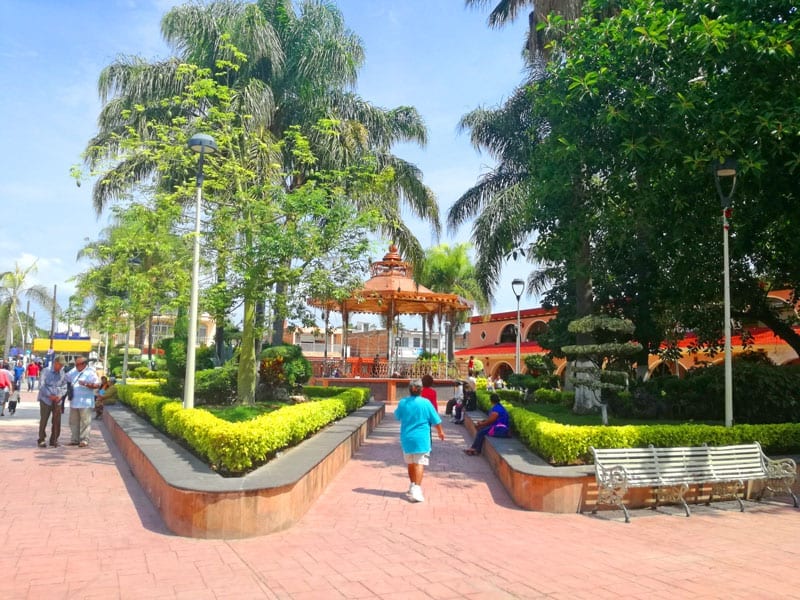
Chapala’s main street is blooming with trees, plants and flowers, making it a beautiful place to rest. Among the varieties found in the area are pine, evergreen oak, palo dulce, huizache, campanilla, caspire, madrono, saucillo, tepame and chaparral.
Almost every plant will grow in this ideal climate, so home gardens usually have a great variety of trees, plants and flowers. Fruit trees – mango, lemon, tangerine, guayaba, orange, banana, avocado – are very common. Grains, fruits and vegetables, sold in the markets, and even from the sidewalks, are always available.
There are a few small farms in Chapala that grow corn, wheat, peas, chick-pea, and sorghum. A small amount of cotton is produced. In the mountains, and by season, nopal and camote are harvested. The nopal is a cactus and is a common ingredient in numerous Mexican cuisine dishes. They can be eaten raw or cooked, used in marmalades, soups stews and salads, as well as being used for traditional medicine or as fodder for animals. The other part of the nopal cactus that is edible is the fruit called the tuna in Spanish, and the “prickly pear” in English. The camote is a wild tuber and is sold as snack and food served in plastic bags, bottle sauce or chili powder tree, salt and a generous dose of lemon juice.
FAUNA

Fauna formerly found in Chapala included dry climate animals such as deer, coyote, skunk, rabbit, squirrel and reptiles. Although most have now disappeared, it is still common to see rabbits and squirrels. Until recently, images of the puma Yagouaroundi which was thought to be extinct in the area were captured by nocturnal cameras set on the hills. Snakes such as the rattlesnake are usually found in the mountains but one can spot non poisonous snakes swimming on the lake shores. Dangerous insects such as scorpions and spiders are seldom seen but are common in the area.
Because of contamination, the fish population of the Lake has been reduced. Charales, white fish (very rare), carp and bagre are still caught by fishermen and consumed by villagers. Today, most fish sold in restaurants is brought from the ocean or the gulf. Charales, a very common treat around Lakeside, is a very small fish, dried and eaten as a snack.
COMMUNICATION

The four-lane Chapala-Guadalajara highway connects with highways to La Barca, Guanajuato and Michoacan. It also takes you to the Miguel Hidalgo Guadalajara Airport (25 minutes away) which has national and international flights.
From Chapala’s central bus station, buses run to and from Guadalajara every half hour. For other destinations, travelers must first go to the Guadalajara bus station, and board another bus.
Near the Chapala bus station you can catch a local bus to Jocotepec or any town along the way.
Chapala has a post office and offers all the services of any big city. In Coldwell Banker is a UPS courier. Telephone service is very good. Cell phone and internet services are available. All around Chapala are public telephones for local and long distance.
ART

Artisans sell their work at Chapala’s Monday tianguis (open air market) and on the malecon (pier) by the Lake. Carved bone and wood, embroidery, typical Mexican dresses and ceramics are the principal products. Prehispanic reproductions are also made locally and sold here. Craftsmen can be commissioned to make furniture of wood, forged iron, and rattan. Chapala is also well known for its candy, made here in a long-established factory. You can find them set on little tables along the highway and on many corners around the area. They are so good customers come all the way from Guadalajara to buy it.
There is an annual art festival in November called Feria Maestros del Arte. The artisans come together once a year to sell their work. It is the most incredible folk art show in Mexico – 40 minutes south of Mexico’s 2nd largest city, Guadalajara. Buyers and collectors come to the Feria from around the world to purchase the highest quality Mexican art at the best prices available.
Another annual festival happening in February is “Al Son de las Olas”, a traditional music festival offering workshops, lectures, musical presentations, and expo and sale of local crafts. The objective of this music festival is the approach and the diffusion of our music, dance, traditional gastronomy to all our municipality as well as the tourists visiting us. In addition it reinforces instruction and experience of local artists by interacting and exchanging knowledge with artists from other regions of our country.
Mariachi musicians from Chapala are famous. Groups travel widely to play at parties, and they are hired for most of the fiestas patronales (celebrations for patron saints) in various towns.
FESTIVITIES
Carnaval
Many fiestas are celebrated by the people of Mexico, but two are especially dear to the hearts of Chapala people. Carnaval, in February, starts off with a “bad humor burial,” proceeds with “allegorical cars,” a procession, music, dance, and then ends with a charreada (rodeo), serenades for the fiesta queen, and a coronation for the Ugly King.
Chapala’s Fiesta Patronal
Perhaps the most important event of the year, Chapala’s Fiesta Patronal, September 25-October 4, honors Saint Francis of Assisi with nine days of fireworks, games, castillo (bamboo tower for pyrotechnic display), dance, music, typical Mexican food, and drink. The main plaza is packed with people each night, promenading in the paseo, eating, drinking, listening to the mariachis, and waiting for the midnight fireworks.
The visit of the Virgin of Zapopan to the city of Chapala
The visit of the Virgin of Zapopan to the city of Chapala has been a tradition for many years. This year she returns accompanied by dancers, music, and thousands of pilgrims who follow the route to the parish of San Francisco and along Lake Chapala. The visit of the Zapopan virgin to Chapala is also an opportunity for the locals to show their devotion to the Catholic faith. Chapala’s main avenue is decorated with flowers and flags in honor of the virgin. In addition, cultural and traditional events are organized to complement the religious activities.
MISCELLANEOUS
The presidency building

The old presidency building was fixed and remodeled and opened its doors in 2015 as the new Cultural Center featuring a theatre with a capacity for 216 people. This new center houses art shows, plays, musicals, and academic presentations all year long.
Chapala banks
Chapala has several banks, several travel bureaus, an investment company, and the oldest real estate firm in the entire area. Downtown is where almost all economic transactions are made, with people coming from all the villages to do business.
It is also the main seat of government for several Lakeside villages. Inside the township’s colonial building are housed almost all of the agencies and departments that administer the legal, civic and ecological life of the area.
Chapala medical clinics
Chapala boasts several medical clinics, some featuring the latest and most modern diagnostic equipment. The Red Cross clinic and ambulance service operates 24 hours a day, 365 days a year, for medical emergencies.
Moreover, Lakeside has a few outstanding retirement homes, with round-the-clock medical assistance available. In Lake Chapala and Guadalajara, you can find world-class healthcare that is as good or even better than what you might find in your home country. Best of all, the cost is a fraction of what you would pay abroad.
Chapala has a yacht club
For sports enthusiasts, Chapala has a yacht club, several good tennis courts, a few beautifully maintained soccer fields and a bullring, as well as fully-equipped health clubs. In recent years, the citizens of Mexico have become much more health conscious, and the town of Chapala reflects this new trend.
Near the lakeshore sits a quaint quay that sports several of the best seafood restaurants in all of Mexico. People from Guadalajara and other towns around come on Sundays to enjoy a nice shrimp cocktail and all that these restaurants offer.
The malecon
The malecon was remodeled expanding and evening the walkways and planting palm trees and other lush tropical plants all along giving it an inviting atmosphere. It is a place for the public to wander down by the lake and purchase food or trinkets from the local vendors. Freshly made ice cream is a favorite treat and is famous around this region. On weekends, the place rocks with lots of tourists, traveling minstrels, balloons, bubbles and more. There is a modern skate board area which is very active with the young showing off their skate boarding skills.
Fishing boats are a mainstay of the scenery here at Lake Chapala. Boats offer you tours around the lake and to the island called La Isla de los Alacranes (Scorpion Island) where you can enjoy nice views of the lake and lake shores all around, see the diverse local and exotic birds. The island houses several little restaurants offering local food dishes.
Parque de la Cristiania
The municipal park situated on the east shore of the lake in the Chapala area called Parque de la Cristiania is walking distance from the malecon. It has a couple of swimming pools and water slides for those hot summer days. An amphitheatre in the middle of the park houses musical and theatrical plays presented by local schools. For the more active type it also has tennis courts and volley ball courts. Lots of picnic areas, green sunny and shaded spaces, are filled with people enjoying a nice day with family and friends.
Chapala railway station to become the "Centro Cultural Gonzalez Gallo"
Back in the 1920s, the introduction of the railroad offered better alternatives for the economic growth of the region, besides providing a nicer ride, as the railroad was more comfortable than the stage coaches which took up to 12 hours to make the trip, or the buses with big solid rubber tires, which also took a minimum of 5 hours to cover the same distance that the railroad did in 3 hours from Guadalajara to Chapala.
After a flood, the railroad operation ceased in 1926 and was abandoned and later bought by a wealthy family but was taken over by squatters.
In 1991, the family donated the building and was remodeled and turned into a museum. Today, the museum also houses an art school offering music, theatre and visual art classes.
Centro Cultural Gonzalez Gallo – Chapala The González Gallo Cultural Center was inaugurated in 2005 and is located in the building that was the old Chapala railway station, in 1920. In it you will find art exhibitions, works by artists such as George Rauch and Miguel Miramontes, permanent exhibits and cultural events.
Read more about: Chapala Railway Station to Become Museum
Architecture in Chapala
The architecture in Chapala, Jalisco, Mexico is rich and varied, with a combination of styles and influences that reflect the history and culture of the region.
The history of architecture in Chapala dates back to the 16th century, when the Spanish founded the city. During the colonial era, many churches and public buildings were built in the Baroque and Neoclassical styles. The church of San Francisco is one of the most outstanding buildings of this period, with its neoclassical façade and its impressive bell tower.
The new and the old are harmoniously integrated in Chapala, and it is not unusual to find a modern facility nestled in between two stately residences whose histories go back several hundred years. The past is well preserved, and hints of village history can be found around nearly every corner.
One example is the former home of the novelist, D.H. Lawrence, who resided here in the early 20s, during the time he was writing one of his most celebrated novels, The Plumed Serpent. Today, the house is one of the best bed and breakfast establishments in Mexico.
Another impressive residence is the former home of the Braniff family. Built around the turn of the century by the scion of the family who later would establish one of the largest airlines in the United States, it is today a fashionable restaurant called Los Cazadores.
Why should you visit Chapala, Jalisco, Mexico?
If you are looking for an exciting tourist destination in Mexico, look no further than Chapala, Jalisco. This enchanting town is known for its scenic beauty, delicious cuisine, and vibrant festivals. Here are some reasons why you should visit Chapala:
• Natural beauty: Chapala is located on Lake Chapala, the largest lake in Mexico. The lake is a beautiful place to relax and enjoy nature. There are also many stunning mountains and natural landscapes to explore.
• Colonial architecture: The Church of San Francisco is an impressive example of Spanish colonial architecture and is a must-see for any lover of history and culture.
• Gastronomy: The food in Chapala is delicious and unique. Try the tamales, mole, and the tequila.
• Exciting Festivals: Chapala is known for its vibrant and exciting festivals that celebrate local culture. The Chapala Carnival, Chapala’s Fiesta Patronal, Feria Maestros del Arte and Al Son de las Olas are some of the most popular festivals.
• Welcoming people: The locals of Chapala are very friendly and welcoming. They will always be willing to help you and welcome you to their beautiful town.
• Accessibility: Chapala is only an hour’s drive by car from Guadalajara, the largest city in Jalisco. It can also be easily reached by bus from Guadalajara.
In summary, Chapala, Jalisco, Mexico is an exciting tourist destination with much to offer. From its natural beauty to its colonial architecture, delicious cuisine and vibrant festivals, there is something for everyone in this enchanting town. Do not miss it!
- What is the location of Chapala?
– Chapala is located on the northern shore of Lake Chapala, 26 km east of the lake’s western end, and 42 km south of Guadalajara.
- What is the average altitude of Chapala?
– The altitude of Chapala is 1530 meters (5020 feet) above sea level.
- What types of tourist activities can be enjoyed in Chapala?
– Chapala offers a variety of tourist activities, such as boat rides on the lake, exploring colonial architecture, enjoying local cuisine, visiting handicraft markets, and participating in cultural festivals.
- What does the name “Chapala” mean?
– The name “Chapala” can have several interpretations, including “Grasshoppers over the water” in Nahuatl and “Place where pots abound” also in Nahuatl.
- What fauna can be found in Chapala?
– Although fauna has decreased due to contamination, rabbits, squirrels, and some snakes can still be found in the region. Additionally, the lake used to be home to fish such as charales, catfish, and carp.
- What type of cultural events are celebrated in Chapala?
– Chapala is known for its vibrant cultural festivals, such as Carnival in February and the Patron Saint Festival of San Francisco de Asís on October 4th. There are also traditional music festivals and art exhibitions.
- What is the history of the presidency building in Chapala?
– The old building where the presidency was previously located was remodeled and converted into the Cultural Center in 2015. The building that now houses the municipal government had been used as a hotel named “El Hotel Nido.”
- What medical services are available in Chapala?
– Chapala has several medical clinics, including a Red Cross clinic that operates 24 hours a day.
- What sports facilities are available in Chapala?
– Chapala has a yacht club, tennis courts, soccer fields, and a bullring. Additionally, there are highly equipped gyms and a wide variety of yoga, meditation, and martial arts groups.
- What tourist attractions can be found near Chapala?
– Near Chapala, visitors can enjoy Scorpion Island on the lake, the Cristianía Park with pools and slides, and the González Gallo Cultural Center, located in the old Chapala train station, as well as a wide variety of restaurants and bars.

